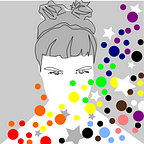Make it so — on why and when design fiction might be the tool for you
I had a couple of conversations recently on why the heck one might go and use design fiction. Oh, and I did a PhD project on design fiction in HCI as a method. So, I think and talk about design fiction quite a bit. One common critique I encounter is that at the end you have nothing. You have not build something. While I enjoy tinkering as much as much as the next person, I heartily disagree with this statement. First, you have built something: a world; a narrative; a artefact within it. That is not nothing. That is not fairy gold. It will not disappear in the morning. It is a manifestation of your thoughts, your world view, your imagination in a shape and form that can be shared with others. Well done, pat yourself on the back. Writing is hard y’all.
Second, it is design fictions advantage that you do not have to build something. There are a couple of reasons of why that might actually be useful. The technology you are thinking about might (yet) be impossible to build. Robots might be a useful example as they are promised to be just around the corner, but they are not quite here yet. And while I don’t want to get into an argument of whether robots will come into our houses and lives anytime soon, there might be a range of reasons for you to think about. As a metaphor for other technologies as example. Or just to think about what might happen if they are really just around the corner.
You might also want to think about technologies on a societal level. Building a technology and getting it widely accepted is a goal that in my experience would be beyond the scope and ability of many PhD projects (otherwise, please let me in on the secret). You have other things to do. You should be writing. Design fiction might be the tool to build the technology and get it accepted in an evening. A week. Go for it. Ask “What if we had XXX” and off you go.
You might want to forget what the thing looks like. Should look like. In writing it is up to you of how detailed you want it to be. The thing needs to be yellow and make a beeping noise? Great, show me the yellow, bleeping thing. You care more how people respond to the idea? Great, tell me what the product does. I’ll imagine the rest. In my opinion — and experience — that makes design fiction a useful tool as a means to explore sensitive topics. You can talk about death without showing bodies. You can talk about sex without showing bodies. You can think about exploitation, manipulation, discrimination without … no, without putting people at risk.
If you can build it easily, quickly and want to gather individual responses on this one thing, by all means go ahead. Build it. Show me. I am curious. I like things. If not, read on.
So, you have grudgingly accepted that building something tangible might not be the right response for you. You have rolled up your sleeve, went to your favourite writing spot and wrote a thing. Mine is in a pub BTW. Imagine where I am now. You have a fiction. What to do with it now?
1) Burn it. You might find that making the story was the most important thing. It helped you thinking through some issues. You came up with ideas. You came to the conclusion is not a good idea after all. You might be slightly scared by your own mind and what it just came up with. Sometimes the writing process can be end of it all. Whether you did it on your own or participatory with others, you might decide to not to do anything else with it. Maybe another drink though?
2) You are really proud of it and you want to show it to people. Fair enough. Throw it into the world. Find a place for it. It is a piece of art, it should be exhibited seen, discussed. Can people get their teeth into it? Can / should it stimulate a discussion? Change a discourse? I am sure design fiction can do all these things. Maybe not one design fiction on its own. But as a sign of the times it might be one way to disrupt the common narrative. It shows up alternatives, puts a spanner into techno-optimist discourse that things are going to happen anyway. Because one can always ask: What if?
3) So, you found that the design fiction has the power to start a discussion? You are a researcher? Surely you will want to harness its powers for good: make it a research tool. Can you gather responses to the design fiction in interviews? Focus groups? What can you learn about technologies by getting people talking out it? Which people? Check out design fiction probes as an approach to your research.
Design fiction can be art, can be research, can be many things in between. Do we need different things to describe these things? Maybe. Are they all reasonable uses for design fiction? Absolutely. Should you go ahead and build a thing?
